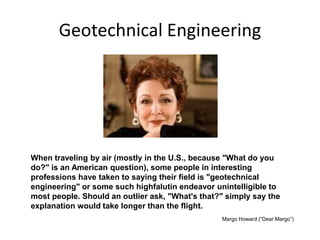The Best Strategy To Use For Geotheta
The Best Strategy To Use For Geotheta
Blog Article
What Does Geotheta Mean?
Table of ContentsGeotheta Fundamentals ExplainedThe Best Guide To GeothetaExcitement About Geotheta10 Easy Facts About Geotheta Explained
They work together with civil designers, architectural engineers, designers, and various other professionals to incorporate geotechnical factors to consider into the total project layout and construction process. This needs effective synergy, sychronisation, and interaction to ensure that the geotechnical aspects align with the task objectives and satisfy regulative demands.Mining & Materials Design: Concepts of exploration, penetration rates, and aspects impacting the choice of exploration approach. Blasting techniques in surface and underground functions. Mechanical and continual approaches to fragmentation, including longwall shearing and fullface boring.
Modelling of piece and bit dimension circulations; comminution as a transfer function. Comminution modern technology: crushing, grinding, dimension category. Integrated evaluation of fragmentation and comminution procedures. Provided by: Mining & Materials Engineering.
The Best Guide To Geotheta
Bachelor's degree programs in civil, geotechnical, geological, and environmental design generally last four years and consist of general education training courses in English, social science, and the liberal arts, as well as training courses in advanced maths, structural geology, and fluid mineralogy. (https://canvas.instructure.com/eportfolios/3071866/Home/Why_Geotechnical_Engineers_Are_Essential_for_Your_Construction_Projects)
Geotechnical engineering involves the evaluation of the soil and rock conditions at a particular site, and their effects for the growth of that website. As the majority of structures rely upon the ground for assistance, it is without shock that an in-depth understanding of the ground conditions, and the viability of foundation systems, are crucial to the lasting security and efficiency of the building or structure.
Specialising in the investigation of geological developments and ground behavior, geotechnical designers perform scientific investigations and testing to comprehend the effect these geological formations may carry the style and building of building, civil and facilities jobs. This knowledge is important for the layout and building and construction of buildings, roadways, passages, dams, bridges, and water and sewer system.
The geotechnical team at Douglas Allies regularly talk to designers, design designers, programmers, and building contractors to make suggestions on layout and advancement propositions to make certain that the built frameworks are accordingly designed for the ground conditions. For example, the design of footing systems needs to think about the weight of the framework, the ability of the ground to sustain that weight with each other with motion resistances and reliable building.
Geotheta for Beginners
This task is substantially simplified by the use our Douglas Map geospatial platform which makes this details conveniently obtainable in an easy to utilize internet browser interface. A geotechnical designer will direct the drilling of boreholes and examination pits to gather dirt and other examples, and also examine surface area functions and ground direct exposures to create a geotechnical version of the subsurface problems.
Depending on the job type and ground conditions ran into, laboratory testing might among other things examine strength, compressibility, reactivity and/or permeability of dirt and rock samples. Hereafter information is accumulated and collected, the results are used for a geotechnical version of the site, which is typically presented as areas throughout the site.

A geotechnical examination by nature can just evaluate the ground conditions at the locations drilled or excavated. Natural variants in soil and rock conditions can occur across a website and in between test areas. It is as a result good practice that the geotechnical designer be maintained throughout construction of the project to supply on-site verification that the ground conditions encountered follow the assumptions and suggestions supplied in the geotechnical investigation record.
All About Geotheta
Geotechnical designers utilize their extensive understanding of soil and rock to assess threat and address issues on varied framework projectsGeotechnical design is a this page specialist branch of civil design which looks at the behavior of earth materials and the application of soil and rock mechanics. Tailings Engineer. As a geotechnical designer, you will assess the physical, mechanical and chemical homes of dirt and rock in order to develop structures, preserving structures and earthworks
Geotechnical engineering is very closely linked to and overlaps with, both engineering geology and ground design - https://www.storeboard.com/geotheta. It's feasible to specialise in geotechnics or help a geotechnical firm however be referred to as an engineering rock hound or a ground designer. As a geotechnical designer, you'll require to: construct and maintain relationships with clients and various other professionals entailed in the website, throughout each projectmaintain safety standards on website be mindful of expense ramifications when you make recommendationsstudy geological maps and aerial pictures from a variety of sources and from various time periodsexamine building prepares to see just how viable they are based on your understanding of the siteinvestigate risks or geological risks for the sitesearch for ecologically delicate functions, such as land fill begin to develop factual and expository ground modelsplan field investigationsdrill and analyse samples of bedrock, soil, groundwater and added materials oversee various other specialists on sitesolve technical problems as they develop, such as unanticipated structures at drill sitesmonitor conditions throughout and after building to make sure frameworks are stable in the brief and long termadding information collected on website to your initial researchcreating geotechnical estimations, drawings, and 2 or three-dimensional computer models interpreting the datamaking recommendations about the suggested use of the site

Report this page